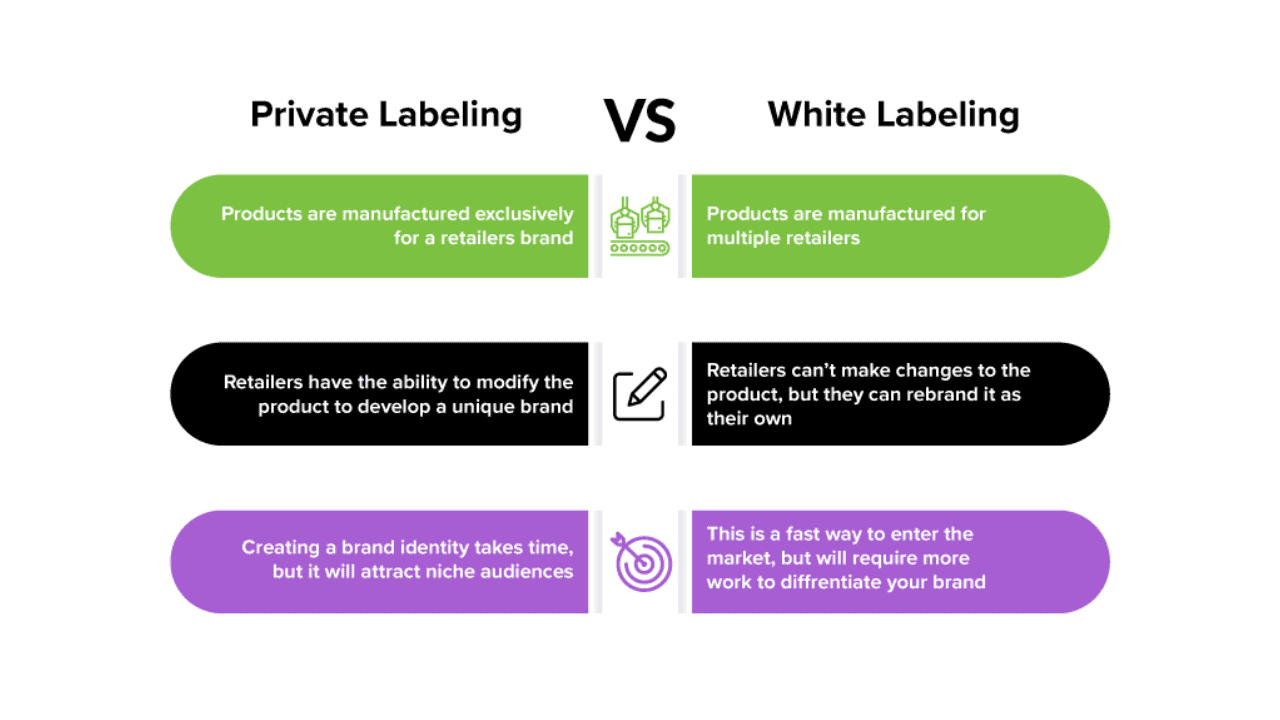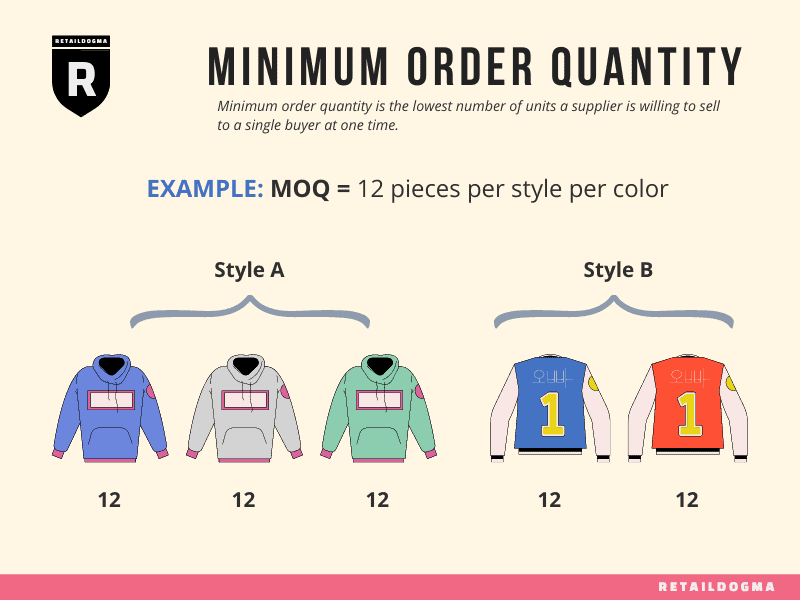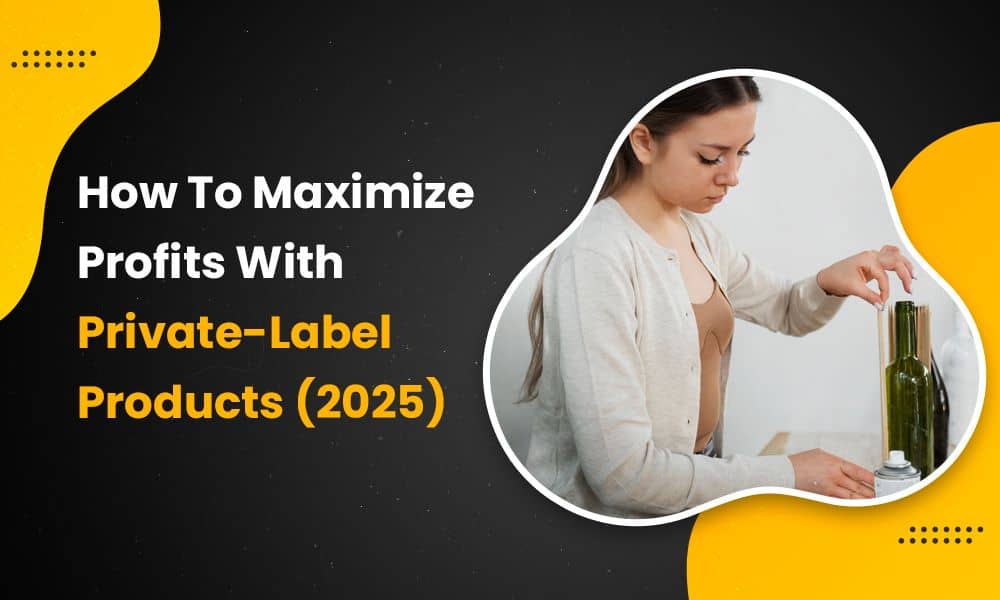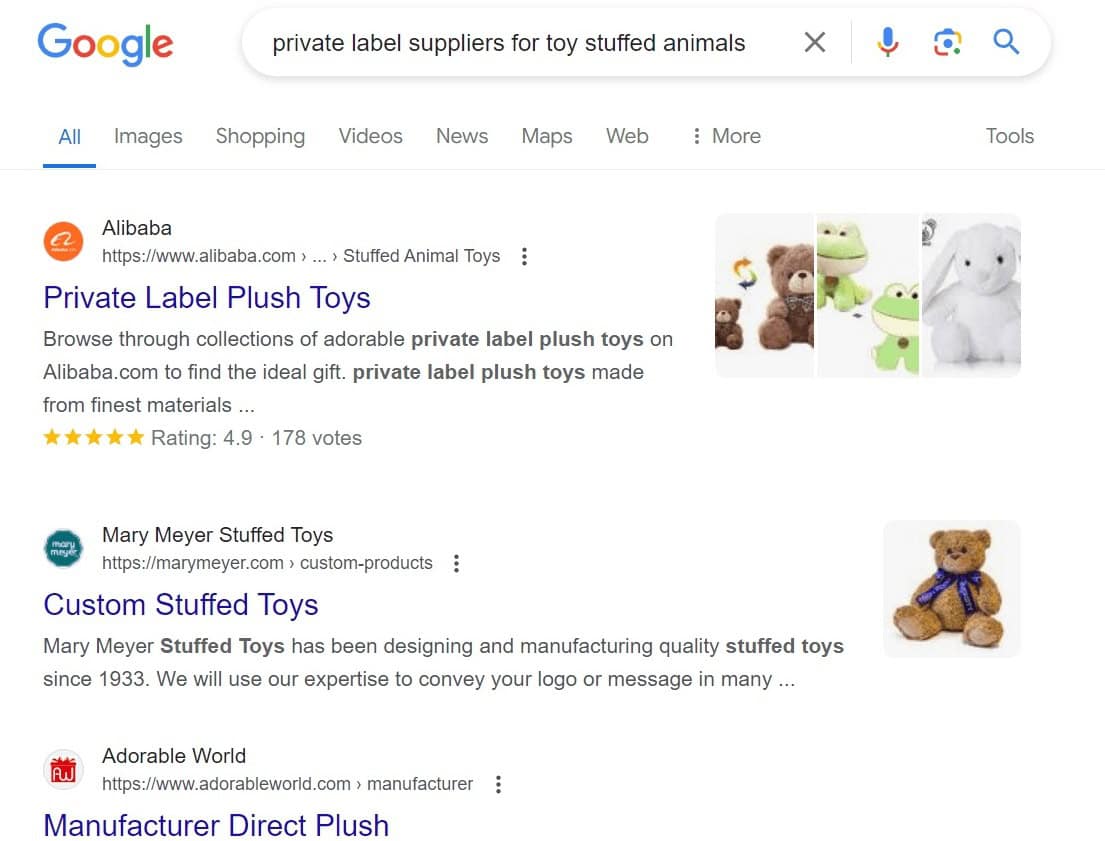Private-label products have become a top choice for retailers. One reason is that private label brands reduce distributing and manufacturing costs by up to 40% and 50% for some products compared to established brands.
Also, consumers have a growing preference for private-label products. According to a report, 82% of consumers prefer white-label products to national products.
So, if you are about to start your private-label products business, this guide is for you. In this blog post, we’ll discuss:
- What private-label is
- How to identify opportunities in private-labeling
- Strategies for branding and marketing your private-label line business
- How to overcome challenges in private-label business
Let’s get started.
Table of Contents
What Are Private Label Products?
Private-label products are produced by a third-party manufacturing company and then branded, marketed, and sold by another company, often referred to as company brands.
Unlike white-label manufacturers, who create generic products sold through multiple retailers, These products are produced according to your specifications and sold under your brand name.

The private label process involves three key components: the retailer/company, the private label manufacturer, and the product idea or design. The process involved typically follows the sequence below:
- A company or retailer comes up with a product idea and pitches it to a private-label manufacturer
- The manufacturer produces the product according to the outlined specification
- The manufacturer supplies the product to the retailer after production
- The retailer or company distributes, advertises, and sells the product to consumers under their brand name
A report shows that 90% of consumers out of 54% who intend to purchase private-label products say they would likely continue to buy them even if nationally branded products become cheaper because private-labeled products offer more value and product quality.
What are the benefits of private-labelling?
Private labeling has several advantages, including reduced manufacturing costs. But beyond private labeling cost, here are three additional benefits private label brands enjoy.
Unique value proposition
The private label business model allows you to contract specialized manufacturers to produce premium products you may not be able to produce independently due to a lack of skilled personnel, technological expertise, production facility, etc.
These private-label goods are exclusive to your brand and come at low prices.
Brand building
You can determine how the products are packaged in private labels.
Since visual brand cues are unique to every business, customers can easily recognize your packaging anywhere. This helps you build brand recognition and customer loyalty.
Additionally, your brand identifiers help you stand out in the crowded marketplace and differentiate you from store-brand products.
Control over marketing practices
As a private-label business owner, you have full control over your products’ sales and marketing strategies.
You can decide on your product line marketing strategy and adjust it to respond to market changes.
High-profit margin
As mentioned earlier, private labeling reduces manufacturing costs by up to 40% and 50% for some products.
Beyond this, you can control your product margins with private-label products, unlike when products are purchased from name-brand counterparts for resale or custom manufacturing. The products already have incurred costs, which makes buying them expensive, and therefore, the cost of resale is even more costly.
However, with private-label products, you can easily adjust marketing prices to suit market demands and remain profitable.
Read also: What is an Enterprise Company? [Simple and Quick Definitions]
Identifying Opportunities in Private Labelling
To gain market share in private labeling, you must first identify high-demand product categories that cater to your target audience’s needs and are not sold by other retailers.
This guide will help you identify private labeling opportunities as an eCommerce business owner.
Research on current trends and customer behaviors
This is the first step in identifying a product opportunity.
This research gives you an idea of what customers need in the market. Some popular product ideas include pet food, dietary supplements, water bottles, hair care products, clothing materials like t-shirts, yoga mats, or home decor equipment.
Let’s analyze some trends in private-labelling to help you uncover opportunities your business can exploit.
Focus on value
Inflation has caused customers to seek out store brands, which usually cost less.
57% of customers think that private-label products offer an above-average value for the price they charge.
Retailer innovation
Retailers are innovative, trying various strategies to increase their sales.
A typical innovative retailer is ALDI, which has a small store footprint, few employees, and a wide range of private-label options.
Premiumization
Businesses offering private label products invest in high-quality products that compete with national brands’ premium products.
This appeals to modern customers’ desire for exclusivity, high quality, and affordable pricing.
Localization
Customers are beginning to find regional offerings and products made with locally sourced ingredients appealing. More giant retailers like Kroger are already implementing this market trend by introducing local products to stores.
Identify unexplored gaps
Carefully observe and identify gaps in market trends and consumer behavior.
Note any product category or strategy the trends inspire. Carry out further research on these product categories to uncover product categories that competitors have yet to offer. This streamlines your list to specific products that are not yet saturated.
Tools like AMZScout can be used to do this research for small business owners.
Check for the products’ profitability
By now, you have an idea of a product opportunity for your small business.
Next, check the profitability of the private-label product. Estimate the manufacturing and selling costs and see if the profit margin is good enough.
Additionally, product costs can vary based on product type, quantity, design complexity, and manufacturer location.
Analyze for scalability and sustainability
Before you invest in building a brand-name product, check for its long-term demand and scalability. Ask questions like:
- How long will it remain relevant to your target audience?
- Are the products you have chosen seasonal?
- Does the company have the capacity to attract an even larger customer base?
- Are there other complimentary products customers who use this product want?
Answering these questions helps you plan your marketing and advertising strategies, enabling you to scale your private-label business and be a long-term player.
How to Source and Create Private Label Products
After deciding on the private label product, you must connect to a third-party manufacturer who can create your desired product.
Here are some steps to find and partner with a reliable manufacturer.
Step 1: Research for private-label manufacturers
This involves scouting through online forums, trade directories, and online marketplace for private label manufacturers in your chosen private label product niche.
You can also identify potential manufacturers by attending in-person events or asking other business owners for recommendations.
This first step is not just about scribbling down manufacturer contacts that you see. It involves reading through the reviews on each manufacturer, learning about their pricing, and examining their manufacturing processes.
If you meet these people at an event or from another business owner, you can ask them for references to their past work and then go ahead and check out reviews on the past work.
Check for customers’ comments on the quality of the product they manufacture and note other business owners’ experience working with the same manufacturer. Only list the manufacturers that have offered the kind of results you desire. To find private-label manufacturers on Google, you must enter a relevant search phrase for the product category for which you need a manufacturer.
For example, you can go to Google and type in “private label suppliers for toy stuffed animals.”
Once the search results appear, you can scan through the numerous lists of manufacturers to see their main products, reviews, and how long they have been in business.
Step 2: Contact the manufacturers
Now that you’ve got a list of potential manufacturers for your private-label product, vet them and reach out to a select few who meet your requirements. Share your desired private-label product and give them your custom designs.
It is good to be very specific and elaborate about what you want.
This helps the manufacturers decide if they can or want to take on the project and at what cost.
Step 3: Request for samples and quote
Before placing a large order for your product, request order samples and a quote for its production. Requesting samples is important as it shows you what to expect. If the samples are satisfactory, you can proceed to the next step.
If areas require improvement, inform the manufacturers and make the necessary corrections before proceeding with the bulk production.
Step 4: Agree on a suitable price and partnership terms
If you are satisfied with the proposed output of your product, go on to agree on the production price. Remember to consider other essential aspects of the partnership, like the payment terms, minimum order quantities, delivery deadlines, warranty, and quality control policies.
You and the manufacturer must clearly understand and agree on these terms for an effective partnership. Ensure the contract is detailed and covers every requirement, responsibility, and consequence guiding your partnership with the manufacturer.
This also ensures the manufacturer agrees to work with you if a problem arises while production is ongoing.
Step 5: Ensure quality control
With the partnership contract done, your job as a small business owner is done. Well, not exactly. Ensure that the manufacturer sets up systems to test the quality of the product throughout the production process.
Additionally, any labeling requirements for the country where production occurs should be considered.
Read also: Advocacy Advertising Explained With Shocking Examples
How to Brand and Market Your Private Label Products
A successful private label business requires effective branding and marketing strategies.
While your products are undergoing production, think of the best packaging that reflects your brand values and protects your product. Here are some strategies and tips for effective branding and marketing.
Invest in unique packaging
A big part of branding your private-label product involves packaging.
This is because the first thing your customer sees about your product is the packaging. To get ideas for your packaging designs, browse your competitors’ products and brainstorm how your designs can stand out from what they have.
Regardless of what you come up with, ensure your brand name and logo are easily visible. It would be profitable for your business if these core brand identities were etched in your customers’ brains.
Draw attention with the right ‘color splash’
Identify colors that make your white-label products come alive and draw customers’ attention when they walk into a store.
Choose the colors that resonate with your product type and brand identity from the identified colors.
Tell stories through your products
All your design elements should work together to showcase your brand and tell customers about your product. Using words or images, showcase the outstanding ingredient in your product and the benefit it offers to customers that use them.
You can also discuss the origin of the product ingredients. Are they eco-friendly? Are they high-quality? This will increase your product’s appeal to the right customer.
However, it would be best if you kept your packaging simple. A cluster of text or design elements can feel overwhelming for customers to read. Therefore, make your packaging easy for customers to digest the essential details you want them to see.
Invest in eco-friendly packaging
Your packaging has two primary duties: to carry your product and to give it an identity.
After providing a packaging design that gives your product the correct identity, the next step is to consider the type of packaging that would best carry your product. To do this, consider the packaging material that can best protect your product and ease of use for your customer.
Making your packaging recyclable helps protect our world and makes your brand appealing to eco-conscious customers. Remember that this customer segment has been steadily increasing since the pandemic.
Therefore, this is profitable even for your business.
Read also: The Invisible Giant — How White Labeling Powers the Brands You Love
Tips to Increase the Visibility of Your Private-label Products
The visibility of your brand is important for your private-label products, and to enhance how well people see you, here are some tips for you:
Identify your major distribution channels
It would help if you decided on the channels your private-label products will be distributed.
By understanding the advantages of each channel and pattern, you can choose the one that will help you achieve your marketing goals. Your channel choice determines the marketing strategies you can implement and those you cannot.
Invest in product visibility strategies
For your customers to purchase your private label product, they must know you have such products, and here are some ways to achieve this:
- Your product page should be mobile-optimized and easy to navigate. It should also contain high-quality product images and testimonials.
- Use high search volume keywords and alt text on your product page. This increases the visibility of your product page when customers search for the product you offer under a private label.
- With over 5.07 billion active social media users, you can leverage social media to reach a wide range of audiences. You can collaborate with influencers and use target ads to get a higher customer base.
Offer promotions and competitive pricing
Calculate your profit and revenue and ensure your production expenses aren’t more. Considering the production cost, product quality, market trends, and customer preferences, the price for private label products should be equal to or lower than the perceived value the product offers.
Offering promotions can attract and encourage more customers to try your private-label products at reduced costs.
Have an excellent customer service
Exceptional customer service may take the form of promptly attending to complaints or questions or fast delivery.
This ensures that the customer has a good experience with your brand and increases the chances of returning to make another purchase.
Monitor and optimize marketing strategies
You should continually monitor your marketing strategy’s KPIs.
Note working strategies and identify areas that can be tweaked to improve sales and attract more visitors. Implement the changes and monitor again.
Read also: How To Find Reliable Dropshipping Suppliers: A Quick Guide
How to Overcome Common Challenges in the Private Labelling Process
Every good venture, small or large, encounters hurdles in its growth process.
The challenges you can expect as a small business and solutions are limitless. However, this section explains how you can solve everyday challenges.
Manage your product quality
This can be challenging, especially since you will work with multiple third-party manufacturers. Some private label manufacturers may not consistently pay attention to the production process, leading to the production of goods with varying quality levels.
The first step in managing this challenge is to be thorough when choosing a private-label manufacturer and communicating your product choice to him/her. Settle with manufacturers with a proven record of producing quality products.
The desired quality standards should also be clearly stated in the contract.
Navigate supply chain disruptions
Disruption in the global supply chain is another challenge that negatively affects businesses with private-label products. Interruptions like shortages of materials and fluctuating costs can affect not only the production schedule but also the quality of the product.
Since disruptions in the global supply chain do not happen everywhere simultaneously, partnering with multiple private-label manufacturers is a great operations strategy to handle this challenge.
These manufacturers should be in different geographic locations to guarantee product production and distribution continuity.
Overcome competition
Competing against already-known national brands with a big marketing budget can intimidate small business owners seeking to venture into private labels.
To stand a chance with established national brands, choose a private-label product focusing on a niche market. Then, the products should be designed with features relevant to potential customers’ needs that national brands have not addressed.
Secondly, to stay above the competition, develop a strong brand identity. This acts as a guideline to ensure your private label line is unique.
Overcome Minimum Order Quantity (MOQ) challenges
Many private-label manufacturers have a minimum order quantity (MOQ) they deliver per batch. These quantities may be too high for small business owners venturing into private labels.
One way to address this issue is by partnering with dropshipping suppliers, often producing smaller quantities than established private label manufacturers.

Future Trends in Private Labelling
To thrive in private labeling, businesses must stay current with market trends and adjust when necessary. Based on consumer behavior, here are trends that will dominate the landscape in the future:
Eco-friendly practices
Due to the pandemic, consumers are more aware of their environment. They want to know that your product development process uses high-quality materials without harming the environment.
With about 41% of customers considering user reviews as a major factor in making buying decisions, it is evident that consumers are looking beyond just what business owners say.
To increase customers’ trust in private label products, businesses must make their production process transparent and commit to eco-friendly practices.
Commitment to sustainability
More and more people are drawn to brands that give back to the environment by using production materials that can be recycled. Businesses and private-label products that would stay relevant in the future will infuse sustainability into their business plans.
Omnichannel presence
With the advancement of technology, customers have come to expect a more convenient shopping process.
Marketing channels should be established on different online platforms. This enables customers to purchase from their channel of choice. To achieve this, you must invest in growing your online presence across different channels and rely on technology to merge your marketing efforts.
This shouldn’t be a hassle, as marketing and sales automation tools like EngageBay enable you to segment your customers, launch personalized marketing campaigns, and manage all customer interactions from a single dashboard. (Read more)
Availability of options
Contemporary consumers like to feel unrestricted.
They would prefer to shop in stores that offer a wide range of private-label products from which they can choose. This is seen in the 14% year-over-year growth experienced by DIY home projects.
A careful look at these predicted trends reveals that they only respond to ever-evolving customer behavior and preferences.
Conclusion
We have discussed the importance of private-label products and how they have become significant in today’s market.
In summary, private-label products give you complete control over your product lines and enable you to double down efforts on the more client-facing part of eCommerce–marketing and sales.
Marketing and sales automation tools like EngageBay enable you to build your social presence across multiple social media platforms, launch marketing campaigns, and manage customer interaction from a single dashboard.
Frequently Asked Questions (FAQ)
1. What are private-label products?
Private-label products are goods manufactured by one company but sold under another company’s brand. Retailers often use private labels to offer exclusive products not found elsewhere.
These products are typically branded with the retailer’s name or a brand they control.
2. How can private-label products benefit my business?
Private-label products can improve your business by offering higher profit margins than branded products. They also allow you to control pricing, production, and quality, differentiate between your product offerings, and build branded products.
3. What are the key factors when starting a private-label brand?
Before starting a private-label brand, key factors include selecting a reliable manufacturer, ensuring product quality, and understanding your target market. You should also consider aspects like trademarks and 100% compliance with regulations.
Developing strong branding and packaging that resonates with customers is also essential.
4. How do I market my private-label products effectively?
You can effectively market your private label products by leveraging social media, partnering with influencers, and targeting online advertising. SEO and content marketing can enhance visibility, attract and retain customers, and drive product traffic.
5. What are the future trends for private-label products?
The future trends for private-label products include a focus on sustainability, with eco-friendly and ethically sourced products gaining popularity. There’s also a growing demand for personalized and niche products tailored to specific consumer needs.

